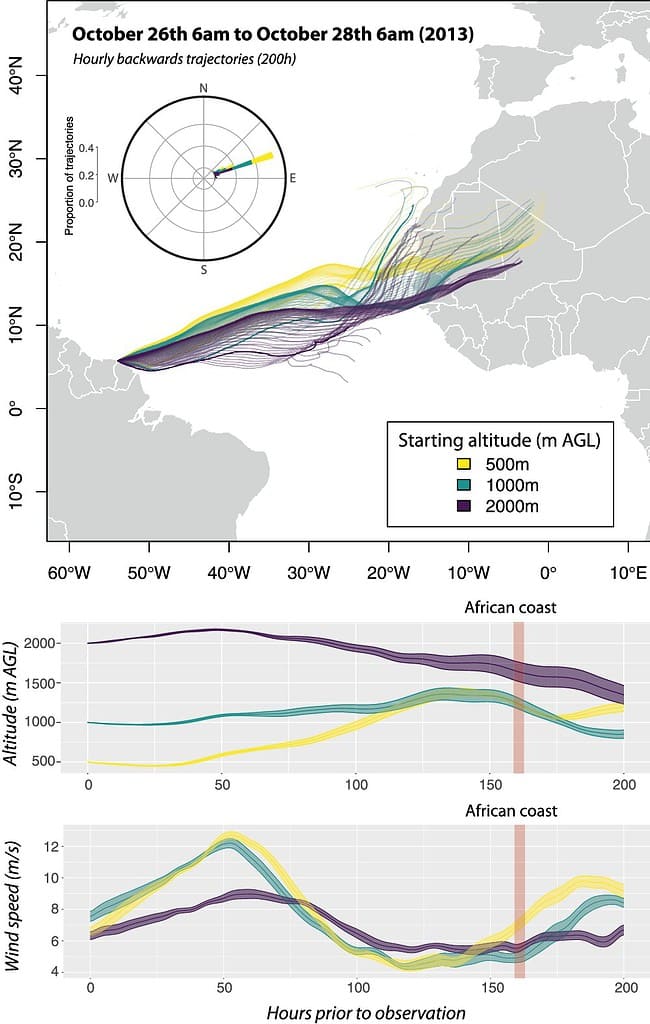A few years ago, Gerard Talavera was working in French Guiana, a country in South America. Talavera, a researcher from the Botanical Institute of Barcelona at CSIC, came across something unexpected: painted lady butterflies.
This species isn’t commonly found in South America, and it prompted Talavera to investigate how the butterfly got there. Now, after groundbreaking multidisciplinary research, scientists have figured it out. The butterfly is capable of a stunning transatlantic journey.
A Painted Lady butterfly (Vanessa cardui). Image credits: Wiki Commons.
Butterflies over the ocean
The butterflies that Talavera observed in French Guiana seemed exhausted and had damaged wings. This species, Vanessa cardui, is known to have remarkable migratory abilities and Talavera was already suspecting a long-range migration. But it’s not easy to prove it.
Painted ladies are already known for extensive migrations across the Sahara. These Sahara migrations can span multiple generations and cover approximately 15,000 km between the Afrotropical and Palearctic regions. However, their presence in South America, outside their native range, indicated an extraordinary dispersal event and a different type of migration.
To get to the bottom of things, the researchers started by analyzing winds across the Atlantic. If the butterflies were really traversing the ocean, they would need to use these winds.
The team reconstructed hourly wind backward trajectories from the capture sites. This analysis showed that the wind trajectories for the 48 hours immediately preceding the capture date were exceptionally favorable for the butterflies to disperse across the Atlantic from West Africa. This suggested that the oceanic migration hypothesis is plausible — but did not prove it.
To prove the migration, researchers turned to genetic analyses.
Genetic analysis and isotopes
The researchers sequenced DNA from pollen grains found on the butterflies, revealing the presence of Sahelian endemic plants like Guiera senegalensis and Ziziphus spina-christi. These plants flower at the end of the rainy season in West Africa. Finding this pollen suggests that the butterflies had visited this African region. The first clue was in place.
Then, they analyzed the genome-wide genetic diversity in the South American samples. These genetic results were compared with individuals from North America, Europe, and Africa. Phylogeographic analyses indicated that the South American butterflies clustered within the European-African population, ruling out a North American origin.
Ultimately, isotope analysis provided the last puzzle piece. Hydrogen (δ2H) and strontium (87Sr/86Sr) isotopes indicated probable origins in Western Europe and West Africa, aligning with the other evidence.
“It is the first time that this combination of molecular techniques including isotope geolocation and pollen metabarcoding is tested on migratory insects. The results are very promising and transferable to many other migratory insect species. The technique should fundamentally transform our understanding of insect migration,” says Clément Bataille, associate professor in the Department of Earth and Environmental Sciences at the University of Ottawa, and one of the study co-authors.
“We usually see butterflies as symbols of the fragility of beauty, but science shows us that they can perform incredible feats. There is still much to discover about their capabilities,” says Roger Vila, a researcher at the Institute of Evolutionary Biology (CSIC-Pompeu Fabra University) and co-author of the study.

How do the butterflies do it?
It’s striking that butterflies can fly over the Atlantic, and researchers also wanted to understand how they could do it.
They estimated the energetic requirements of the butterflies using different flight strategies. They found that without wind assistance, the butterflies could travel a maximum of 780 km before needing to refuel. However, with the help of the easterly trade winds, they could travel up to 1,900 km. By using an alternating flight strategy of active flight and minimum-effort gliding, similar to monarch butterflies, the painted ladies could sustain the journey across the Atlantic in 5 to 8 days, provided they had sufficient fat reserves.
“The butterflies could only have completed this flight using a strategy alternating between active flight, which is costly energetically, and gliding the wind. We estimate that without wind, the butterflies could have flown a maximum of 780 km before consuming all their fat and, therefore, their energy,” says Eric Toro-Delgado, one of the article’s co-authors.
Nature in motion
This study highlights the underestimated capacity for long-distance dispersal in insects. The discovery of butterflies completing such a journey suggests that other insects may also engage in similar long-range migrations. The role of trade winds as aerial highways connecting continents is crucial, particularly for insects that rely on wind assistance for long-distance travel.
The painted ladies’ transoceanic flight is a testament to the incredible adaptability and resilience of insects. It also serves as a reminder of the complex interplay between biology and atmospheric dynamics that shapes the natural world. This discovery opens new avenues for research into insect migration and highlights the importance of preserving the delicate balance of our planet’s ecosystems.
“I think this study does a good job of demonstrating how much we tend to underestimate the dispersal abilities of insects. Furthermore, it’s entirely possible that we are also underestimating the frequency of these types of dispersal events and their impact on ecosystems,” says Megan Reich, a postdoctoral fellow at the University of Ottawa who also co-authored the study.
Journal Reference: Tomasz Suchan et al, A trans-oceanic flight of over 4,200 km by painted lady butterflies, Nature Communications (2024). DOI: 10.1038/s41467-024-49079-2
Thanks for your feedback!
Author :
Publish date : 2024-06-26 13:29:40
Copyright for syndicated content belongs to the linked Source.
—-
Author : theamericannews
Publish date : 2024-06-27 14:17:17
Copyright for syndicated content belongs to the linked Source.